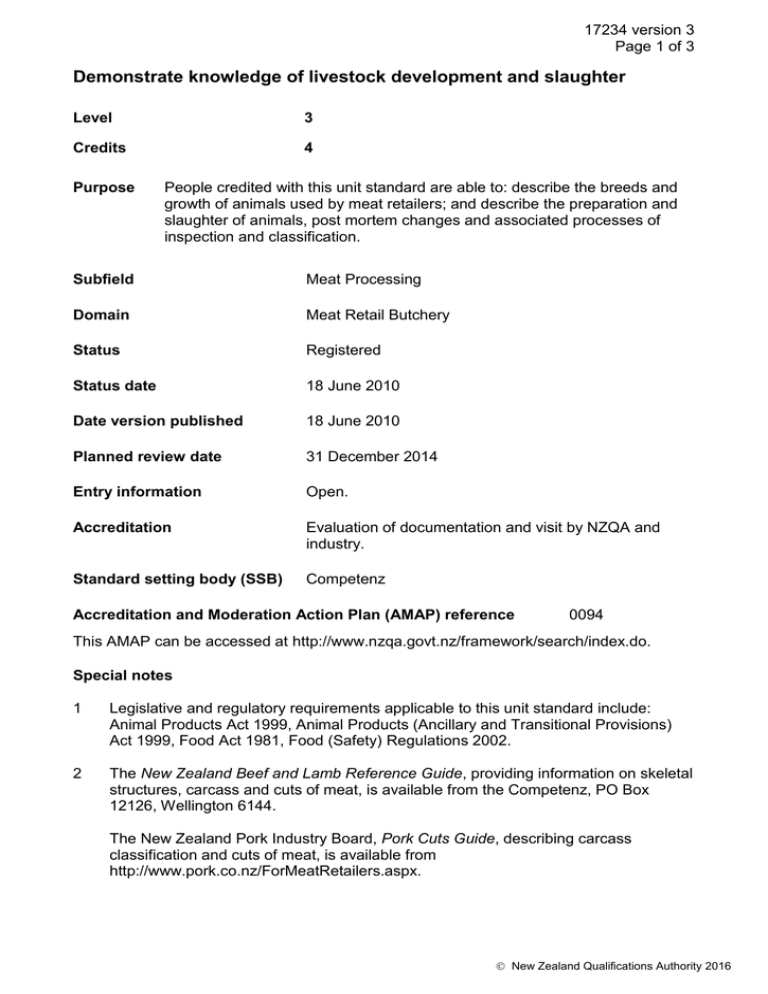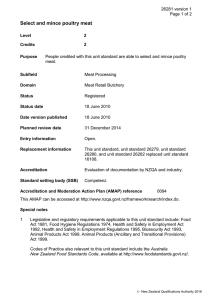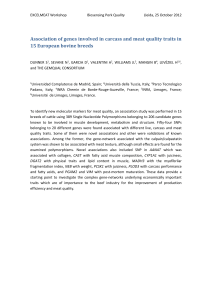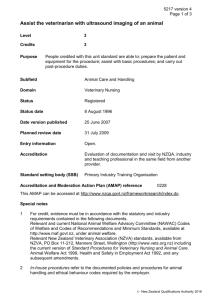Demonstrate knowledge of livestock development and slaughter
advertisement

17234 version 3 Page 1 of 3 Demonstrate knowledge of livestock development and slaughter Level 3 Credits 4 Purpose People credited with this unit standard are able to: describe the breeds and growth of animals used by meat retailers; and describe the preparation and slaughter of animals, post mortem changes and associated processes of inspection and classification. Subfield Meat Processing Domain Meat Retail Butchery Status Registered Status date 18 June 2010 Date version published 18 June 2010 Planned review date 31 December 2014 Entry information Open. Accreditation Evaluation of documentation and visit by NZQA and industry. Standard setting body (SSB) Competenz Accreditation and Moderation Action Plan (AMAP) reference 0094 This AMAP can be accessed at http://www.nzqa.govt.nz/framework/search/index.do. Special notes 1 Legislative and regulatory requirements applicable to this unit standard include: Animal Products Act 1999, Animal Products (Ancillary and Transitional Provisions) Act 1999, Food Act 1981, Food (Safety) Regulations 2002. 2 The New Zealand Beef and Lamb Reference Guide, providing information on skeletal structures, carcass and cuts of meat, is available from the Competenz, PO Box 12126, Wellington 6144. The New Zealand Pork Industry Board, Pork Cuts Guide, describing carcass classification and cuts of meat, is available from http://www.pork.co.nz/ForMeatRetailers.aspx. New Zealand Qualifications Authority 2016 17234 version 3 Page 2 of 3 3 Livestock that may be used for assessment against this unit standard are cattle, sheep, and pig breeds. Elements and performance criteria Element 1 Describe the breeds and growth of animals used by meat retailers. Performance criteria 1.1 The common breeds and cross breeds are described in terms of production of retail product. Range a minimum of three breeds or cross breeds. 1.2 The different stages of growth at which animals are presented for slaughter are identified and described using the industry terminology given to breeds to indicate their maturity. 1.3 The environmental and health factors which influence meat production are described. Element 2 Describe the preparation and slaughter of animals, post mortem changes and associated processes of inspection and classification. Performance criteria 2.1 The preparation of animals for slaughter is described in terms of the influence on carcass meat quality. Range the description includes the factors during preparation which influence the quality of carcass meat – animal stress, exhaustion, injury, disease, ingested drugs, insecticides. 2.2 The humane slaughter of animal species for human consumption is described in terms of requirements in licensed meat processing premises. 2.3 Post mortem changes are described. Range 2.4 changes outlined include – the effect of electrical stimulation, the process of rigor mortis, ageing time, holding temperatures, weight loss through evaporation, pH level. The description outlines the purpose and processes of meat inspection prior to and following slaughter. New Zealand Qualifications Authority 2016 17234 version 3 Page 3 of 3 2.5 The description outlines the purpose of classification following slaughter and how features of the carcass are classified. Range the description may include but is not limited to – carcass type, sex, maturity, fat, muscle, trim, weight. Please note Providers must be accredited by NZQA, or an inter-institutional body with delegated authority for quality assurance, before they can report credits from assessment against unit standards or deliver courses of study leading to that assessment. Industry Training Organisations must be accredited by NZQA before they can register credits from assessment against unit standards. Accredited providers and Industry Training Organisations assessing against unit standards must engage with the moderation system that applies to those standards. Accreditation requirements and an outline of the moderation system that applies to this standard are outlined in the Accreditation and Moderation Action Plan (AMAP). The AMAP also includes useful information about special requirements for organisations wishing to develop education and training programmes, such as minimum qualifications for tutors and assessors, and special resource requirements. Comments on this unit standard Please contact the Competenz info@competenz.org.nz if you wish to suggest changes to the content of this unit standard. New Zealand Qualifications Authority 2016







